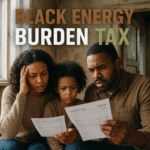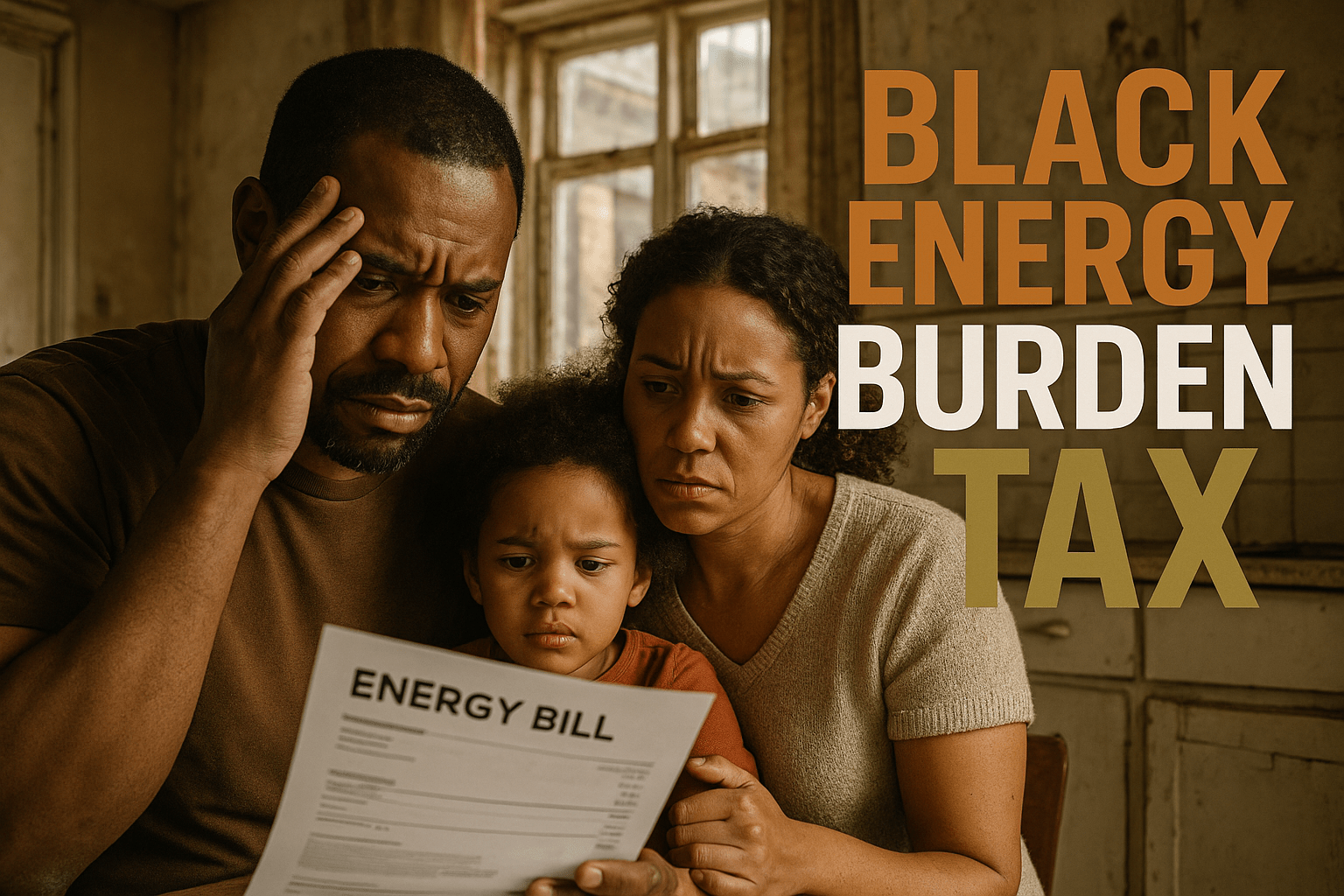

Black Energy Burden: A Hidden Tax
By Darius Spearman (africanelements)
Support African Elements at patreon.com/africanelements and hear recent news in a single playlist. Additionally, you can gain early access to ad-free video content.
Running a household—from heating and cooling to keeping the lights on—is an expensive necessity. However, these costs do not impact all Americans equally. Recent research reveals a significant inequity: Black Americans consistently spend a greater share of their income on energy costs than their white counterparts (spglobal.com).
A groundbreaking national analysis led by George Homsy, Associate Professor at Binghamton University, sheds light on this long-overlooked issue. His study, published in Energy Research & Social Science, is one of the most comprehensive of its kind, analyzing data from 65,000 census tracts nationwide. Homsy, who heads Binghamton’s Environmental Studies Program, examined what is known as “energy burden,” which is the portion of household income spent on essentials like heating, electricity, cooking, and cooling (newsone.com). This burden refers to the disproportionate percentage of household income that low-income households, particularly those in communities of color, spend on energy costs (ourenergypolicy.org). This can lead to significant financial strain and energy insecurity (brookings.edu).
Understanding Energy Burden
While the average U.S. household allocates about 3.2% of its income to energy expenses, the data tells a more troubling story for minority communities (newsone.com). Even when controlling for income levels, Black households consistently face higher energy burdens (spglobal.com). Latino households also experience elevated burdens, although slightly less. These disparities have serious implications. A high energy burden can strain a family’s budget to the point where trade-offs must be made, sometimes at the cost of basic needs like healthcare, transportation, or nutritious food (newsone.com). For many, energy is not just a monthly bill; it is a barrier to financial stability and well-being.
Energy insecurity, the inability to consistently afford and access adequate energy services such as heating, cooling, and electricity, is a direct consequence of high energy burdens (brookings.edu). This forces households to make difficult choices between paying energy bills and meeting other essential needs. For instance, families might keep their homes at unsafe temperatures to reduce energy costs, or they might forgo groceries or medicine to pay utility bills (brookings.edu). Such decisions can lead to significant health risks, including increased susceptibility to heat-related illnesses and chronic stress (brookings.edu).
Understanding Energy Burden

Energy Burden: This refers to the disproportionate percentage of household income that low-income households, especially those in communities of color, spend on energy costs. This financial strain can lead to energy insecurity, forcing difficult choices between utility bills and other basic necessities like food or healthcare.
Discriminatory Housing Policies
Homsy attributes the elevated energy costs in part to the growing cost of rent nationwide and the prevalence of aging and inefficient housing (newsone.com). Black communities are more likely to live in older homes that need repairs, properties that often suffer from poor insulation, outdated appliances, and other maintenance issues that drive up energy use (newsone.com). These conditions are not accidental; they are a direct result of historical discriminatory housing policies, such as redlining (visualizingenergy.org). Redlining systematically denied services, including mortgages and insurance, to residents of certain areas, often based on race or ethnicity. This practice concentrated marginalized communities in neighborhoods with older, less energy-efficient housing, creating a lasting legacy of inequity that directly impacts energy costs (visualizingenergy.org).
Rental units also present significant challenges. Tenants typically lack the authority to make improvements or install energy-efficient upgrades (newsone.com). As a result, the cycle continues, and the burden only grows heavier. Data obtained by Grist in 2022 revealed that rental units in the U.S. consume, on average, 15% more energy per square foot than owner-occupied homes (newsone.com). Renters often have limited control over improving energy efficiency, with small fixes like switching lightbulbs or applying plastic window insulation being among the few options available. Meanwhile, landlords typically lack the incentive or money to invest in more substantial upgrades—such as installing better insulation, replacing windows, sealing air leaks, or updating old appliances—since they are not the ones paying the utility bills (visualizingenergy.org). This is known as the “split incentive problem,” where the party responsible for investing in energy efficiency improvements (the landlord) does not directly benefit from the energy savings, as the tenant is responsible for paying the utility bills (visualizingenergy.org). This lack of incentive often leads to less energy-efficient rental properties and higher energy burdens for renters.
The Impact of DEI Rollbacks
To make matters worse, many tenants are unaware of how energy efficient—or inefficient—their homes are. Progress on this issue has been slow, as energy transparency in housing remains limited. Currently, only a handful of U.S. cities require landlords to disclose energy usage information to potential renters. Adding to these challenges, the rollback of Diversity, Equity, and Inclusion (DEI) programs by utility providers, particularly in the South, is exacerbating energy inequities for Black households (capitalbnews.org). Seven of the largest utility providers across the South have quietly rolled back their diversity measures (capitalbnews.org).
When DEI programs vanish, so do mentorships for Black engineers, goals for hiring Black and brown workers, and internal advocacy against discriminatory rate hikes (capitalbnews.org). These programs are designed to address systemic inequities that lead to disproportionate energy burdens for marginalized communities (brookings.edu). Their removal can exacerbate disparities by eliminating targeted support and initiatives aimed at improving energy affordability and access for these groups. Effective public policy, including those that fall under DEI, can counter some of the problems associated with high energy burden (visualizingenergy.org).
Statistical Realities
The disproportionate energy burden on Black households and renters is clearly reflected in statistical data. In July of last year, 50% of Black renters were unable to pay their energy bills (brookings.edu). This alarming figure underscores the severe financial strain faced by many Black families. While the average U.S. household allocates about 3.2% of its income to energy expenses, Black households consistently face higher energy burdens, indicating a systemic issue rather than individual financial mismanagement (newsone.com).
Furthermore, rental units in the U.S. consume, on average, 15% more energy per square foot than owner-occupied homes (newsone.com). This higher consumption directly translates to higher costs for renters, who are often Black and low-income. Regression models from the EIA 2015 RECS estimate energy used at the household level for space heating, water heating, air conditioning, and electricity for home electronics, appliances, and miscellaneous uses (sciencedirect.com). These models consistently show that households in communities of color experience energy poverty at a rate 60% greater than those in white communities (ncbi.nlm.nih.gov).
Geographic and Climate Variations
Energy burdens exhibit significant geographic variation, influenced by factors such as climate, housing stock, and energy sources (visualizingenergy.org). Understanding these regional and urban/rural differences is crucial for developing targeted and effective policy solutions. For example, urban communities tend to have higher utility bills compared to rural communities, partly due to historical discriminatory practices that have shaped where different communities reside (visualizingenergy.org).
State-level analysis further demonstrates wide spatial disparities. In states like Maine, residential heating oil and fuelwood remain common heat energy sources, impacting costs differently than in states like Alabama and Mississippi, which have among the lowest net energy returns on average (ncbi.nlm.nih.gov). Moreover, increasing extreme temperatures due to climate change exacerbate energy burdens, particularly for vulnerable populations, by increasing the demand for cooling and heating, thereby raising utility costs (brookings.edu). This directly links energy inequity with the urgent need for climate resilience strategies, as energy insecurity is described as a “lethal manifestation of climate vulnerability” (brookings.edu).
Policy Solutions for Energy Equity
Addressing the energy burden requires a multi-faceted approach with specific policy solutions. These include direct financial assistance, investments in energy efficiency, and broader systemic reforms to utility practices and housing. State and local government interventions could include energy bill assistance programs, which provide direct financial relief to struggling households (brookings.edu).
Furthermore, retrofitting and weatherizing homes, especially older rental units, can significantly reduce energy consumption and lower bills (brookings.edu). Investing in neighborhood heat resilience, such as creating cooling centers and increasing green spaces, can also mitigate the impact of extreme temperatures (brookings.edu). Expanding access to affordable, renewable energy sources can provide long-term relief from volatile energy prices (brookings.edu). Public Utility Commissions (PUCs) can also pursue cost containment policies, including reforms to utility return on equity (ROE), economic dispatch, and clean repowering, to support affordability (rmi.org). Arrearage Management Programs (AMPs) can help customers pay down their debts and return to a regular payment schedule (rmi.org).
Black Renters Unable to Pay Energy Bills
This chart shows that 50% of Black renters were unable to pay their energy bills in July of last year. Source: Brookings.edu
Empowering Black Homeowners
For Black homeowners, lawmakers statewide need to implement a yearly energy evaluation—also known as an energy audit or assessment—free of cost. The inspection would help to cut energy costs and evaluate exactly how a home uses energy and pinpoint where improvements can be made to boost efficiency (newsone.com). According to the U.S. Department of Energy, a professional energy assessment may include a walk-through inspection, use of infrared cameras to detect heat loss, blower door tests to locate air leaks, and other diagnostic tools. Once completed, the evaluation should provide a clear, cost-effective plan to upgrade a home, targeting the areas with the greatest potential for savings (newsone.com).
Some municipalities are beginning to take action. In Burlington, Vermont, for example, the City Council unanimously passed an ordinance that went into effect on January 1, 2022, setting minimum energy efficiency standards for rental properties. Among the new requirements: residential rental units must use less than 90,000 British thermal units (BTUs) per conditioned square foot annually for space heating—a move aimed at reducing energy waste and protecting tenants from excessive utility costs. These local initiatives demonstrate that policy changes can make a tangible difference in alleviating energy burdens and promoting energy equity.
ABOUT THE AUTHOR
Darius Spearman has been a professor of Black Studies at San Diego City College since 2007. He is the author of several books, including Between The Color Lines: A History of African Americans on the California Frontier Through 1890. You can visit Darius online at africanelements.org.
